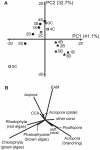High macroalgal cover and low coral recruitment undermines the potential resilience of the world's southernmost coral reef assemblages
- PMID: 21991366
- PMCID: PMC3185058
- DOI: 10.1371/journal.pone.0025824
High macroalgal cover and low coral recruitment undermines the potential resilience of the world's southernmost coral reef assemblages
Abstract
Coral reefs are under increasing pressure from anthropogenic and climate-induced stressors. The ability of reefs to reassemble and regenerate after disturbances (i.e., resilience) is largely dependent on the capacity of herbivores to prevent macroalgal expansion, and the replenishment of coral populations through larval recruitment. Currently there is a paucity of this information for higher latitude, subtropical reefs. To assess the potential resilience of the benthic reef assemblages of Lord Howe Island (31°32'S, 159°04'E), the worlds' southernmost coral reef, we quantified the benthic composition, densities of juvenile corals (as a proxy for coral recruitment), and herbivorous fish communities. Despite some variation among habitats and sites, benthic communities were dominated by live scleractinian corals (mean cover 37.4%) and fleshy macroalgae (20.9%). Live coral cover was higher than in most other subtropical reefs and directly comparable to lower latitude tropical reefs. Juvenile coral densities (0.8 ind.m(-2)), however, were 5-200 times lower than those reported for tropical reefs. Overall, macroalgal cover was negatively related to the cover of live coral and the density of juvenile corals, but displayed no relationship with herbivorous fish biomass. The biomass of herbivorous fishes was relatively low (204 kg.ha(-1)), and in marked contrast to tropical reefs was dominated by macroalgal browsing species (84.1%) with relatively few grazing species. Despite their extremely low biomass, grazing fishes were positively related to both the density of juvenile corals and the cover of bare substrata, suggesting that they may enhance the recruitment of corals through the provision of suitable settlement sites. Although Lord Howe Islands' reefs are currently coral-dominated, the high macroalgal cover, coupled with limited coral recruitment and low coral growth rates suggest these reefs may be extremely susceptible to future disturbances.
Conflict of interest statement
Figures






Similar articles
-
Priority effects in coral-macroalgae interactions can drive alternate community paths in the absence of top-down control.Ecology. 2022 Dec;103(12):e3831. doi: 10.1002/ecy.3831. Epub 2022 Sep 19. Ecology. 2022. PMID: 35862066 Free PMC article.
-
Spatial and temporal patterns of eastern Australia subtropical coral communities.PLoS One. 2013 Sep 13;8(9):e75873. doi: 10.1371/journal.pone.0075873. eCollection 2013. PLoS One. 2013. PMID: 24058705 Free PMC article.
-
Resilience potential of an Indian Ocean reef: an assessment through coral recruitment pattern and survivability of juvenile corals to recurrent stress events.Environ Sci Pollut Res Int. 2017 May;24(15):13614-13625. doi: 10.1007/s11356-017-8772-4. Epub 2017 Apr 9. Environ Sci Pollut Res Int. 2017. PMID: 28391465
-
Climate change impacts on coral reefs: synergies with local effects, possibilities for acclimation, and management implications.Mar Pollut Bull. 2013 Sep 30;74(2):526-39. doi: 10.1016/j.marpolbul.2013.06.011. Epub 2013 Jun 28. Mar Pollut Bull. 2013. PMID: 23816307 Review.
-
Influence of upwelling on coral reef benthic communities: a systematic review and meta-analysis.Proc Biol Sci. 2023 Mar 29;290(1995):20230023. doi: 10.1098/rspb.2023.0023. Epub 2023 Mar 22. Proc Biol Sci. 2023. PMID: 36946114 Free PMC article.
Cited by
-
Turning up the heat: increasing temperature and coral bleaching at the high latitude coral reefs of the Houtman Abrolhos Islands.PLoS One. 2012;7(8):e43878. doi: 10.1371/journal.pone.0043878. Epub 2012 Aug 29. PLoS One. 2012. PMID: 22952797 Free PMC article.
-
Small Marine Protected Areas in Fiji Provide Refuge for Reef Fish Assemblages, Feeding Groups, and Corals.PLoS One. 2017 Jan 25;12(1):e0170638. doi: 10.1371/journal.pone.0170638. eCollection 2017. PLoS One. 2017. PMID: 28122006 Free PMC article.
-
Grazing deterrents improve survival of outplanted juvenile corals.Coral Reefs. 2025;44(4):1389-1401. doi: 10.1007/s00338-025-02703-z. Epub 2025 Jul 5. Coral Reefs. 2025. PMID: 40741425 Free PMC article.
-
Decadal demographic shifts and size-dependent disturbance responses of corals in a subtropical warming hotspot.Sci Rep. 2024 Mar 15;14(1):6327. doi: 10.1038/s41598-024-56890-w. Sci Rep. 2024. PMID: 38491152 Free PMC article.
-
Spatial variation in abundance, size and orientation of juvenile corals related to the biomass of parrotfishes on the Great Barrier Reef, Australia.PLoS One. 2013;8(2):e57788. doi: 10.1371/journal.pone.0057788. Epub 2013 Feb 28. PLoS One. 2013. PMID: 23469067 Free PMC article.
References
-
- Bellwood DR, Hughes TP, Folke C, Nyström M. Confronting the coral reef crisis. Nature. 2004;429:827–833. - PubMed
-
- Nyström M, Folke C. Spatial resilience of coral reefs. Ecosystems. 2001;4:406–417.
-
- Sheppard CRC. Predicted recurrences of coral mortality in the Indian Ocean. Nature. 2003;425:294–297. - PubMed
-
- Donner SD, Skirving WJ, Little CM, Hoegh-Guldberg O, Oppenheimer M. Global assessment of coral bleaching and required rates of adaptation under climate change. Glob Change Biol. 2005;11:2251–2265. - PubMed
-
- Hughes TP, Baird AH, Bellwood DR, Card M, Connolly SR, et al. Climate change, human impacts, and the resilience of coral reefs. Science. 2003;301:929–933. - PubMed
Publication types
MeSH terms
LinkOut - more resources
Full Text Sources
Research Materials

